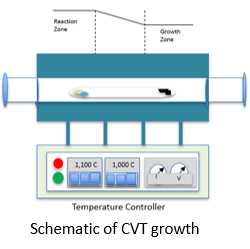Crystal Growth and Property Tuning of Topological Quantum materials
Student: Krishna Pandey
Degree: Ph.D., December 2022
Major Professor: Dr. Jin Hu
Research Area(s):
Nanoscale Materials & Devices
Background/Relevance
-
Moore’s law became challenging below 10nm due to emerging quantum effects.
-
Topological quantum materials with exotic properties are promising for electronic, optoelectronic, and spintronic devices.
Innovation
-
Observe the symmetry-protected electronic states of in Dirac nodal-line semimetal of ZrSiS-family.
-
Tuning the exotic properties of the materials.
Approach
- Grow single crystals using chemical vapor transport and flux methods.
- Structural and elemental characterization using x-ray diffraction (XRD) and energy dispersive spectroscopy (EDS).
- Characterize the electronic properties of the topological Dirac fermions in single crystal.
- Tune the lattice and composition of the material; characterize the evolution of the Dirac states using resistivity, Hall effect, and quantum oscillation measurements.

Key Results
- Successful growth of ZrXY ( X=Si, Ge; Y=S, Se Te), LnSbTe (Ln=La, Ce, Gd, Sm, Pr, Nd) single crystals using chemical vapor transport and flux method.
- Magnetization, Heat capacity measurement shows the AFM ground state with enhanced electronic correlation in NdSbTe and SmSbTe.
- Collaborative ARPES study shows the topological Dirac States in SmSbTe.

Conclusions
-
Single crystals of Dirac nodal-line semimetal are synthesized by chemical vapor transport and flux method.
-
SmSbTe, NdSbTe materials are antiferromagnetic and PrSbTe and LaSbTe does not have magnetic transition till 2K.
Future Work
-
Tune the properties of ZrXY and LnSbTe using magnetic field and strain.
-
Characterize the evolution of the Dirac states using resistivity, Hall effect, and quantum oscillation measurements.
-
Extend area of research to the other materials showing similar properties.

